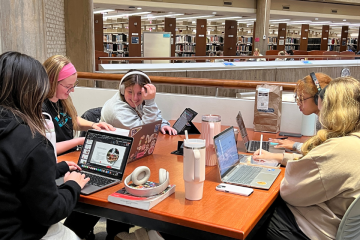Fifty Years of Widener Women’s Sports

Fifty years ago, the Chester campus was awash in change.
Declining enrollment and financial stress had led to the disbanding of the cadet corps and the transition to a civilian-only institution. The school had a new name, Widener College, and new school colors, blue and gold.
The student body was more diverse than ever before, with the population of female students, at the once all-male military college, expanding dramatically.
Women began enrolling in 1966 in what was then-called PMC Colleges, and “really started making the institution their own very quickly,” said Jill Borin, university archivist.
Women were involved in extracurricular activities, took on leadership roles, and earned academic accolades. By 1970, both The Dome student-run newspaper and the Penn Morton College Student Government Association were led by women. The first sororities appeared on campus, and women joined the once all-male PMC cheerleading team.
But cheerleading was an extracurricular activity for women; varsity athletics still eluded them.
That all changed in 1972, when newly named Widener College fielded its first varsity women’s teams – field hockey and basketball.
Read more about the transition of 1972
Melissa McCarthy, current field hockey coach, believes her sport was one of the first because the region is a “hotbed of field hockey,” with robust high school feeder programs.
Field hockey honored its 50th season through a fundraising initiative; by asking alumnae what five decades of Widener field hockey meant to them and sharing their responses on social media; and by inviting a large group of alumnae back for Homecoming this year.
Field hockey also marked its golden year by earning a trip to the Middle Atlantic Conference (MAC) Commonwealth Championship for the first time in program history, and tying the school record for most wins in a season.
“We really just wanted to make the biggest statement possible,” said McCarthy. “It’s a real honor to be part of the school’s legacy, not just with this past season and what we’ve been able to accomplish.”
In 1982, just 10 years after women’s basketball debuted, the team punched its first ticket to the NCAA tournament. It was also their first year of eligibility, as the NCAA didn’t start the women’s basketball championship event until the 1981-82 season.
Widener would be back at the big dance in 2004, 2009, 2013, and 2020 – all under Coach Alisa Kintner’s leadership.
Today’s basketball program is built on the foundation of those early teams, especially the 1982 squad, said Kintner. “That’s where I think we’ve gone as a whole, from the culture of 1982 and what they did.”
Like field hockey, women’s basketball marked its 50th year in style by reaching the MAC Commonwealth Championship.
Just as Widener was fielding women’s basketball and field hockey, the United States passed the landmark Title IX, which prohibits sex-based discrimination in federally-funded educational programs. One byproduct of Title IX was a rise in female athletic programs nationwide.
Most believe the bill’s passage and the start of varsity women’s sports at Widener are a coincidence of timing. “But,” as McCarthy notes, “Title IX created opportunity in general for women. There were more women at Widener and now they had a platform like Title IX.”
By 1973-74, Widener had added women’s softball, swimming, track, and tennis to their roster.
Today’s Widener includes 11 NCAA-sponsored women’s teams and 11 men’s teams, plus Esports (a co-ed team), and cheerleading.
“We offer the same, if not more programs, than most of our conference competitors,” said Larissa Gillespie, associate athletics director and senior woman administrator.
Gillespie attributes Widener’s deep offerings for women to the growth and size of the female student body, driven, in part, by the university’s well-regarded nursing program. Unlike other institutions, Widener makes it possible for students to pursue nursing – with its rigorous academic and clinical responsibilities – while also playing a sport.
Much has evolved over the decades in women’s athletics overall, and at Widener specifically.
Gillespie, who has been at the university since 1994 (first as a student, then as a coach and administrator), has seen an increased focus on the “whole” female athlete.
As is the case with male athletes, there’s an emphasis today on strength and conditioning and nutrition.
In addition, the athletic facilities today are more on an even playing field for men and women; coaches are, by and large, no longer coaching multiple sports; the staff includes female athletic trainers; and there is an overall increase in support for female student-athletes.
“I’ve seen tremendous growth in respecting the needs of female student-athletes and their sports,” said Gillespie. “There’s a different level of respect for women’s athletics today.”







